#railway bridge construction
Explore tagged Tumblr posts
Text
MKC Infrastructure Ltd is one of the leading road and bridge construction companies in India that is committed to overcoming all challenges to put the foundation of a future that empowers the nation. We use cutting-edge technologies and best practices for civil engineering, industrial building construction, railway bridge construction, and similar projects. We aim to transform our team to augment every aspect of the lives of people we touch"
#Highway Construction Company#Construction Road Company#Bridge Construction Company#Railway Bridge Construction#Industrial Building Construction
1 note
·
View note
Text
Bagbera Water Supply Scheme to Launch Before Durga Puja
Project delayed due to railway bridge issues; 60% of pipeline work completed Jamshedpur’s long-awaited Bagbera water supply project is set to become operational before the Durga Puja festival. JAMSHEDPUR – The Bagbera water supply scheme in Jamshedpur, delayed for years, is now slated to begin operations before the upcoming Durga Puja festival. Executive Engineer clarified the delay was caused by…
#जनजीवन#Bagbera water supply scheme#district council meeting#Dr Kavita Parmar#Durga Puja deadline#Jamshedpur Development#Jamshedpur Infrastructure#Kharkhai river bridge#Life#Preeti Enterprises#railway bridge construction#water pipeline project
0 notes
Text

#heading home for my granddad's funeral#i would very much like to not go there#but at least the weather is nice#photography#fotografie#lensblr#photographers on tumblr#shitty pictures mobile phone#or more like#pictures from my shitty mobile phone#bridge#train#metal construction#railways
13 notes
·
View notes
Text
fuck it im NOT gonna specialize in concrete and steel constructions. imma choose bridges, roads and railways
#just had a conversation with roommie and we agreed that regular constructions suck so bad#+ already starred making plans how after getting the engineer degree we're gonna taake a half year break before going fot masters jdjshs#because no way we're gonna go back to uni right after graduation#that being said those are some great plans considering we're currently getting killed while on our 3rd year#but honestly the specialization choice is actually so damn easy#projects from bridges roads railways - fun! and projects classes are with nice lecturers!#projects from constructions - boring as fuck and literally worst people have project classes there#there is also geotechnics but we don't talk about geotechnics
15 notes
·
View notes
Note
tell me the story on when you were a jerk
:)
ah. Tis but the truth...I have not always been this kind and lovable gremlin...
Once I was a jerk! And it was some weird phase? Idk..
So basically, in my 5th grade elementary school I had a group of great friends! We'd always hang out! But I think I started talking to the mean kids and well.. Its like they converted my smooth brain to become an absolute nightmare! I was really rude to my friends and they were always just left confused. I made one 4th grade student cry because I decided to push them over and step on their hand, I made one other 5th grade student shed a tear after I yeeted him off the jungle gym.. (( I'm sorry :,] )) And once, I was talking some trash to the quiet kid, calling her some names... You know, 5th grade stuff... And she was Pissed. Ok I'm telling you DON'T MESS WITH THE QUIET KID... She dropped all of her things, cracked her knuckles, then punched me so hard in the stomach that I forgot how to breath for a solid 5 seconds. THAT WAS A STRONG PUNCH!!! I was just sitting on the floor looking at her. I was just like... trying to process what happened. She then pjcked up her stuff and walked past... well no she walked on and then past me. She stepped on my hand... Shocker.
...Don't be a jerk guys! You'll get punched so hard that you'll be knocked back to 1st grade! I was converted back to good boi after that. My friends forgave me! 🥲👍
((Shoutout to Nancy from 5th grade. You have strong punches and I'm scared of you))
#2 stories I guess....#owchie#There isn't many people that I'm scared of. You all know I'm an asskicker#a badass even... now imagine me being terrified of Nancy...#Yeeeeah...#At least#WAIT WTH#WHEN I TYPED “AT LEAST” IT SAID...#at least 13 dead in horror nightclub fire in spain as inferno rips through packed birthday party#at least 35 scottish schools confirmed to have dangerous concrete – full list of council areas affected#at least 26 dead and many trapped after railway bridge collapses while under construction in india#WHAT THE FU-
30 notes
·
View notes
Text

Construction works of the bridge over the Euphrates river on the Baghdad Railway line by Jarabulus, Syria
French vintage postcard
#sepia#photography#baghdad railway#vintage#railway#postkaart#euphrates#ansichtskarte#ephemera#carte postale#postcard#postal#works#line#briefkaart#bridge#photo#construction#syria#baghdad#tarjeta#historic#french#river#postkarte#jarabulus
5 notes
·
View notes
Text
Cable Stayed Bridge - Types, key features and construction
A cable stayed bridge is a modern engineering marvel known for its strength, efficiency, and aesthetic appeal. It uses one or more towers to support the bridge deck through a series of cables, which transfer the load directly to the foundation. Unlike suspension bridges, the cables in a cable stayed bridge connect directly from the deck to the towers in a straight line. This design provides…
#bridges#cable stayed bridge construction#cable stayed bridge design example#cable stayed bridge images#cable stayed bridge surat#cable stayed bridge types#cable stayed railway bridge in india#cable stayed suspension bridge#extradosed bridge vs cable stayed bridge#travel
0 notes
Text
At least 26 dead and many trapped after railway bridge collapses while under construction in India | In Trend Today
At least 26 dead and many trapped after railway bridge collapses while under construction in India Read Full Text or Full Article on MAG NEWS

View On WordPress
#At least 26 dead and many trapped after railway bridge collapses while under construction in India#Celebrities#Money#Motors#Politics#ShowBiz#Sport#Tech#UK#US#World
0 notes
Text
At least 26 dead and many trapped after railway bridge collapses while under construction in India | In Trend Today
At least 26 dead and many trapped after railway bridge collapses while under construction in India Read Full Text or Full Article on MAG NEWS

View On WordPress
#At least 26 dead and many trapped after railway bridge collapses while under construction in India#Celebrities#Money#Motors#Politics#ShowBiz#Sport#Tech#Trends#UK#US#World
0 notes
Text
60 Years of the Tokaido Shinkansen!

On 1 October 1964, a railway line like no other opened. Connecting Tôkyô and Ôsaka, paralleling an existing main line, the Tôkaidô New Trunk Line had minimal curves, lots of bridges, zero level crossings. Striking white and blue electric multiple units, with noses shaped like bullets some would say, started zooming between the two cities as at the unheard-of speed of 210 km/h.
This was the start of the Shinkansen, inaugurating the age of high-speed rail.
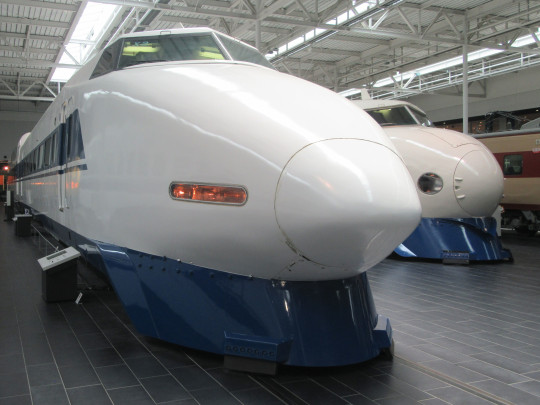
The trains, with noses actually inspired by the aircraft of the time, originally didn't have a name, they were just "Shinkansen trains", as they couldn't mingle with other types anyway due to the difference in gauge between the Shinkansen (standard gauge, 1435 mm between rails) and the rest of the network (3'6" gauge, or 1067 mm between rails). The class would officially become the "0 Series" when new trains appeared in the 1980s, first the very similar 200 Series for the second new line, the Tôhoku Shinkansen, then the jet-age 100 Series. Yes, the 200 came first, as it was decided that trains heading North-East from Tôkyô would be given even first numbers, and trains heading West would have odd first numbers (0 is even, but never mind).
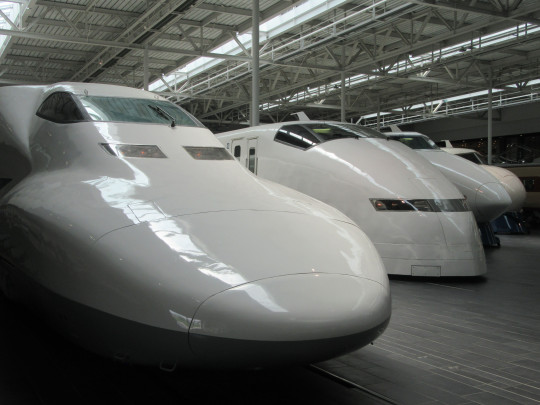
Hence the next new type to appear on the Tôkaidô Shinkansen was the 300 Series (second from left), designed by the privatised JR Tôkai to overcome some shortcomings of the line. Indeed, the curves on the Tôkaidô were still too pronounced to allow speeds to be increased, while all other new lines had been built ready for 300 km/h operations. But a revolution in train design allowed speeds to be raised from 220 km/h in the 80s to 285 km/h today, with lightweight construction (on the 300), active suspension (introduced on the 700 Series, left) and slight tilting (standard on the current N700 types).

Examples of five generations of train used on the Tôkaidô Shinkansen are preserved at JR Tôkai's museum, the SCMaglev & Railway Park, in Nagoya, with the N700 prototype lead car outdoors. It's striking to see how far high-speed train technology has come in Japan in 60 years. The network itself covers the country almost end-to-end, with a nearly continuous line from Kyûshû to Hokkaidô along the Pacific coast (no through trains at Tôkyô), and four branch lines inland and to the North coast, one of which recently got extended.
東海道新幹線、お誕生日おめでおう!
#Japan#Shinkansen#Tokaido Shinkansen#0 Series#60th Anniversary#100 Series#300 Series#700 Series#JR Tokai#I'm posting this just after midnight Japanese time#oh well#late to the party#新幹線#東海道新幹線#0系#JR東海#Nagoya#SCMaglev & Railway Park#train#2023-07
98 notes
·
View notes
Text
The anti seasick ship SS Bessemer Saloon Steamship
The SS Bessemer Saloon Steamship- SS Bessemer for short - was an experimental Victorian passenger side wheel steamer designed to counteract seasickness and operated between Dover and Calais. Her inventor was Sir Henry Bessemer.

Bessemer Saloon Steamer, 1874
In 1868, Bessemer, who suffered from severe seasickness, developed the idea of a ship whose passenger cabin - the saloon - was to be suspended on a gimbal and mechanically held horizontally, thus levelling out the swell and sparing the occupants from the ship's movements. Sounded too good to be true, but more on that later. He patented this ingenious idea in December 1869 and after successful trials with a model in which the levelling was carried out by hydraulics controlled by a helmsman observing a spirit level, Bessemer founded a limited company, the Bessemer Saloon Steamboat Company Limited, which was to operate steamships between England and France. Capital of 250,000 pounds was used to finance the construction of a ship, the SS Bessemer, whose chief designer was the naval architect Edward James Reed.

SS Bessemer, by Henry Spernon Tozer 1874
And so she was built by Earle's Shipbuilding in Hull. She bore the shipyard number 197 and was launched on 24 September 1874. As already mentioned, she was a paddle steamer with four buckets (two buckets each on port and starboard, one forward and one aft). She had a length of 106.68 m (350 feet), a width on deck of 12.19 m (40 feet), an outside width over the bucket boxes of 19.81 m (65 feet), a draught of 2.26 m (7 feet 5 inches) and a gross register tonnage of 1974 tonnes. What also characterised her was that she was completely identical fore and aft, she had two bridges and two wheels, which simply made her faster and more manoeuvrable in both directions. Her maximum speed was about 17.4 knots.
The inner saloon was a room 70 feet long (21 metres) and 30 feet wide (9.1 metres), with a ceiling 6.1 metres above the floor, Moroccan-covered seats, partitions and spiral columns of carved oak and gilded panels with hand-painted murals. The press liked to call it the floating clubhouse. However, the swinging saloon was only intended for first class passengers. The second class, on the other hand, did not enjoy this and had to make do with cabins on the sides of the hull.

Harper's Weekly Interior Pages showing the newly building ultra Luxury Bessemer Channel Steam-Ship, 1874
The disaster begins
On 21 October 1874, the Bessemer had her first misfortune. She had just arrived in Hull to be fitted out when she was driven ashore in a storm. She was refloated and found to be undamaged, which was not entirely true, as would later become apparent.
In March 1875, the ship sailed on a private trial voyage from Dover to Calais. During this voyage she is said to have steered well and even had a top speed of 18 knots. Her swinging saloon is also said to have worked excellently. However, things didn't go so smoothly because on arrival in Calais, a paddle wheel was damaged when she crashed into the pier because it didn't react to the rudder at slow speed.
The first and only public voyage took place on 8 May 1875, with the ship sailing with her revolving cabin locked (some observers suggested this was due to the ship's severe instability, but Bessemer attributed this to lack of time to repair the previous damage). The ship was operated by the London, Chatham and Dover Railway. After two attempts to enter the harbour, it again crashed into the Calais pier, this time destroying part of it. Calais billed the company £2800 for the damage.

The Bessemer Saloon-Ship running foul of Calais Pier. Illustrated London News, 1875
Due to the poor performance, investors lost confidence and the company was dissolved in 1876. On 29 December 1876, the Bessemer ran aground on Burcom Sand in the Humber upstream of Grimsby, Lincolnshire, after the removal of the swivelling saloon and other extensive alterations. She was refloated and taken to Hull. The Board of Trade's investigation into the grounding found that the captain was at fault. His certificate was suspended for three months.After removal, the designer Reed had the saloon cabin taken to his home, Hextable House, Swanley, where it was used as a billiard room. When the house was later converted into a women's college, Swanley Horticultural College, the saloon was used as a lecture theatre, but was destroyed by a direct hit when the college was bombed during the Second World War.

The Saloon as a lecutre theatre
The ship was then docked in Dover until it was sold for scrapping in 1879.
The Theory of the Top. Volume IV, by Felix Klein, Arnold Sommerfeld, London, 2010
The Nautical Magazine for 1874
Sir Henry Bessemer, F.R.S.: An Autobiography, 1905
The Gale, The Times. No. 28140. London. 23 October 1874. col E, p. 8.
London, Chatham & Dover Railway Company
177 notes
·
View notes
Photo

Sydney Harbour Bridge Construction
The Sydney Harbour Bridge – affectionately known as The Coathanger by Australians – was opened to great fanfare and a touch of scandal on 19 March 1932 and was the longest steel arch bridge in the world at the time, with a span of 503 metres (1,650 ft) and standing at 134 metres (440 ft) above Sydney harbour.
Sydney Harbour Bridge During Construction
State Library of New South Wales (Public Domain)
Before the bridge was constructed, there were two Sydneys – the north side, with a population of around 300,000, and the south side and central business district, with 600,000 people. A regular and reliable ferry service took passengers across the harbour, carrying 13 million annually by 1908. There was also a land route from the south to the north shore, which was a time-consuming journey known as the 'five bridges' – horses and cars crossed a series of bridges over the Parramatta River, a detour that added 20-30 kilometres (12-19 mi) to the trip.
As Sydney's population grew and up to 75 ferries crisscrossed the harbour, often in dangerous and foggy conditions, the need for a bridge to connect the northern and southern shores gained momentum. One extraordinary man, Dr John Job Crew Bradfield (1867-1943), envisioned a structure that would unite Sydney – a minimalist, sweeping steel structure embodying modernist design aesthetics, breaking free from the city's convict-era agrarian roots.
Early Designs
Charles Darwin's grandfather, Dr Erasmus Darwin (1731-1802), was inspired by reports of the NSW colony and mentioned the vision of a 'proud arch' in his poem Visit of Hope to Sydney Cove, near Botany Bay, published in 1789. However, the first person to seriously propose a harbour bridge was the emancipated convict and New South Wales (NSW) government architect Francis Greenway (1777-1837). In an 1815 report to Governor Macquarie (1762-1824), Greenway raised the idea and also wrote to the editor of The Australian newspaper, which published Greenway's letter on 28 April 1825:
Thus in the event of the Bridge being thrown across from Dawes Battery to the North Shore, a town would be built on that shore, and would have formed with these buildings a grand whole, that would have indeed surprised anyone entering the harbour; and would have given an idea of strength and magnificence that would have reflected credit and glory on the colony and the Mother Country.
(The Australian, Letter to the Editor)
Greenway's vision was never adopted. The engineering skills and steel technology to span the harbour were not yet available, and the NSW colony was focused on agricultural production and settlement.
The next proposal was put forward in 1857 when English-trained engineer Peter Henderson designed a bridge from Dawes Battery (now Dawes Point on the south side) to Milsons Point. Henderson had worked with Isambard Kingdom Brunel (1806-1859), the renowned and groundbreaking 19th-century engineer who designed London's Paddington Station, the Great Western Railway linking London with the west of England and South Wales, and various steamships.
Sketch of Proposed Sydney Harbour Bridge
P. E. Henderson (Public Domain)
Henderson's sketch for a cast iron bridge supported by two pylons on either side of the harbour is the oldest existing practical plan. The population and economic activity on the northside in 1857 were not significant enough to convince the colonial government. It is also likely that engineering knowledge at the time would have resulted in a bridge that may have fallen into the harbour. Cast or wrought iron, which is not as strong as steel, might not have been capable of withstanding the stresses of a large span in a harbour with strong tides and a city frequently buffeted by high winds.
By the turn of the century, north shore residents had formed the Sydney and North Shore Junction League, championing a bridge inspired by the vision of Sir Henry Parkes (1815-1896), a local politician and five-time premier of NSW. Parkes had called for a bridge to improve transportation and promote urban development. This resulted in Minister for Works E. W. O'Sullivan (1846-1910), announcing a design competition in January 1900. Submissions were received from local and international engineers.
Continue reading...
40 notes
·
View notes
Text
The Transatlantic Railway, part 7
We've finished all of our public consultations, and now we have prepared the final presentation to obtain the project's approval. Please review the slides carefully before you come to a decision. Whatever happens, thank you all for taking part in this project – your contributions are just as vital as from those who will actually build the bridge. Although, as our estimates suggest that this project will completely eliminate unemployment in the UK, US, and Ireland, it's quite likely you'll have the opportunity to work on the bridge's eventual construction.








With that, we now have the final poll of this project:
If you're curious, here are some citations:
Cost of the bridge: estimated based on looking at the cost per kilometer of like two bridges on wikipedia, multiplying by the length of our bridge, and then taking order of magnitude estimates
And for the US federal budget (you can hover over for dollar amounts, click on each box to see that department's spending breakdown):
#network rail#network rail polls#transatlantic railway#I had to say brought to you by the US Department of Defense because otherwise this decision would be too easy#It's strange how the US government spends more money on healthcare than defense#and then has a very effective military (possibly the most effective) but then doesn't have univeral healthcare#Anyway that's not really relevant but it was worth a mention
26 notes
·
View notes
Text
What did Jonathan Harker see in Budapest?
Welcome to Budapest, my dear friend Jonathan Harker! :) Reading Dracula again I’ve noticed that while Jonathan was writing about taking “a little walk through the streets” the things he mentions in his diary, the splendid bridges and the traditions of Turkish rule, are quite far from the train station. So I’ve decided to follow him and try to guess what did he actually see.
First thing first, Jonathan’s train most likely had arrived to the Eastern Railway Station, where most of the Vienna trains had arrived and from where all the trains to Klausenburg (Kolozsvár / Cluj Napoca) had departed.
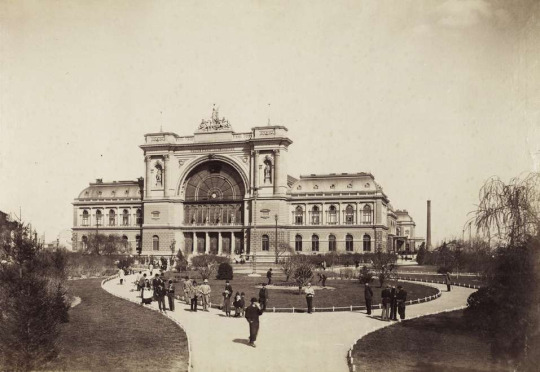
Then, if Jonathan walked all the way to the Danube, he definitely could see some of “the most western of splendid bridges”, like the Franz Joseph Bridge (today’s Liberty Bridge). Or maybe not. The Franz Joseph Bridge were opened in 1896 so if Jonathan visited Budapest before Dracula was pulished he most likely saw the bridge being constructed, an impressive sight nonetheless.
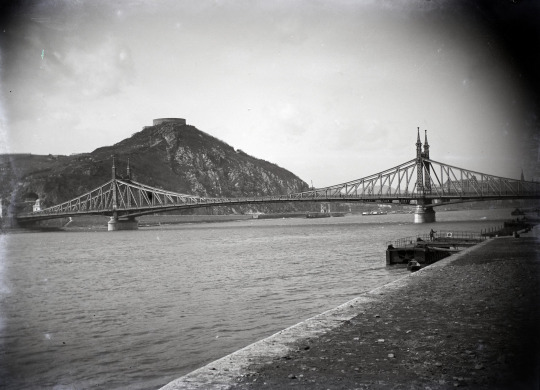
Or the Chain Bridge (with the Royal Palace on the Castle Hill in the background). It takes almost an hour to walk from the Eastern Station to either of the bridges, so Jonathan did not walk a little, he did walk a lot. And if he wanted to see everything else he wrote about, he had to walk even more!
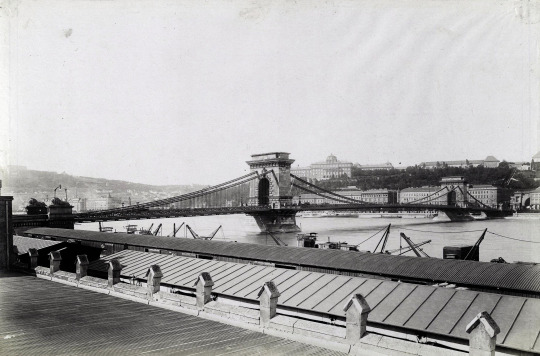
You see, funny thing is, all “the traditions of Turkish rule” are on the Buda or the west side of the Danube, which means that Jonathan’s beautiful description of leaving the West and entering the East is not correct at all. But if he wandered to the western side of the river, he definitely could see some buildings dating back to the Ottoman era, like the Rudas Baths, an original turkish bathhouse still in use. (Okay, this picture is from the 1960s, but the Rudas Baths still looks like this.)
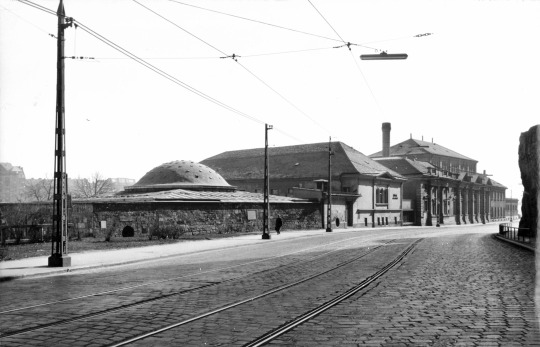
All he could see on the eastern side of the city was some moorish style architecture from the 19th century, like the Great Synagogue of Pest, which is an extremely beautiful building, but it has nothing to do with the Turks.
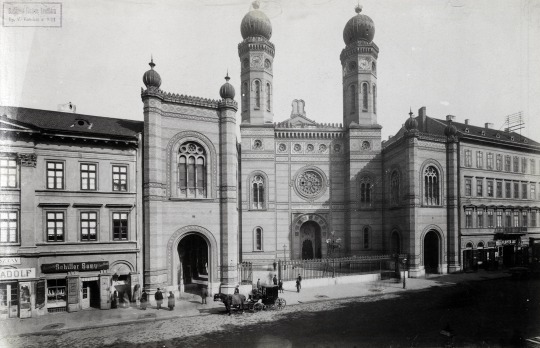
All in all, if Jonathan could see all of this and got back to the station in time to catch his train, he is quite the champion of city walking! Or maybe he just took the tram. All of the photos above (except the one of the Rudas Baths) are from around 1897, the year Dracula was first published.
Sources (because I’m a good dutiful librarian):
Eastern Railway Station: Fortepan / Budapest Főváros Levéltára. Levéltári jelzet: HU.BFL.XV.19.d.1.08.034
Liberty Bridge: Fortepan / Budapest Főváros Levéltára. Levéltári jelzet: HU.BFL.XV.19.d.1.08.107
Chain Bridge: Fortepan / Budapest Főváros Levéltára. Levéltári jelzet: HU.BFL.XV.19.d.1.08.078
Rudas Baths: Fortepan / Budapest Főváros Levéltára. Levéltári jelzet: HU_BFL_XV_19_c_11
Great Synagogue: Fortepan / Budapest Főváros Levéltára. Levéltári jelzet: HU.BFL.XV.19.d.1.07.137
#personal#history#hungary#budapest#bram stoker#dracula#dracula daily#sightseeing with our friend jonathan#i love to be a librarian
607 notes
·
View notes
Note
33 just went and fixed the train. Sure. Why not. Objectively the most useful and productive creature out there


……………
…Well, obviously, it was because my citizens required a way to move to the new Iterator…and a bridge would have been far too expensive of an investment for something that would not have been able to cover the great distance between No Way Back and I. Thus…a railway system was created between our structures, a much more worthwhile construction. That was why, wasn’t it...? And as you can see, it continues being useful even in the current times. So yes. 33 had the correct judgement.
69 notes
·
View notes
Text

3rd November 1934 saw the death of Sir Robert McAlpine aka “Concrete Bob”
Robert McAlpine was born in 1847 in the Scottish village of Newarthill near Motherwell. From the age of seven he worked in the nearby coal mines, leaving at 16 to become an apprentice bricklayer.
McAlpine famously pioneered the use of concrete in construction, one of his first triumphs being the spectacular Glenfinnan Viaduct, familiar to millions through the Harry Potter films. Standing more than 30 metres high, this magnificent 21-arch viaduct is part of the 64km Fort William to Mallaig extension of the West Highland Railway. The bridge, made more famous in the last twenty odd years as the Harry Potter Bridge, is only recently requiring a getting a £3.4m facelift, but remarkably the longevity and quality of the workmanship means, unlike other bridges, it doesnt have to be clad in scaffolding, check out the video for details om this.
Working for an engineerConcrete Bob progressed to being a construction foreman before starting in 1869 to work on his own account at the age of 22. He had no capital other than that he could earn himself and his first contract involving the employment of other men had to be financed by borrowing £11 from the butcher!
From there, McAlpine enjoyed rapid success. In 1887, Robert took his two eldest sons, Robert junior and William, out of school to help him, with Malcolm and Alfred following soon after. Today the company approaches it sixth generation and 150 years of Family ownership and management.
McAlpine died while at sea onboard MV Warwick Castle of a cerebral haemorrhage. He was 87 years old.
25 notes
·
View notes